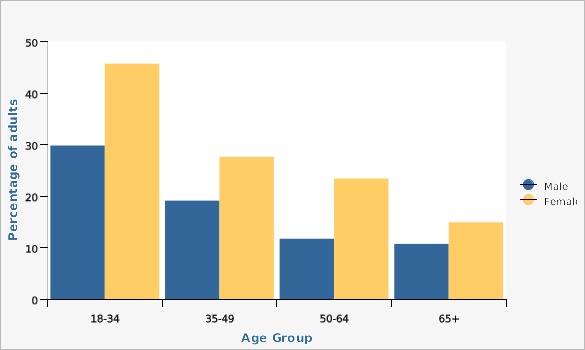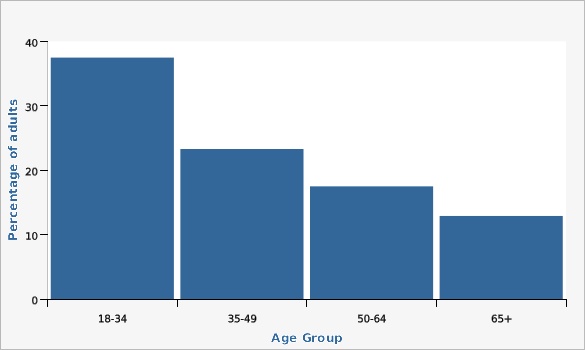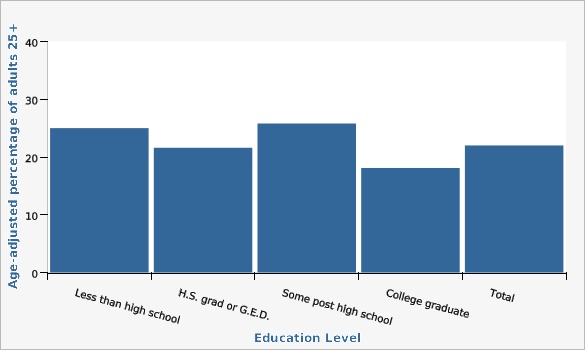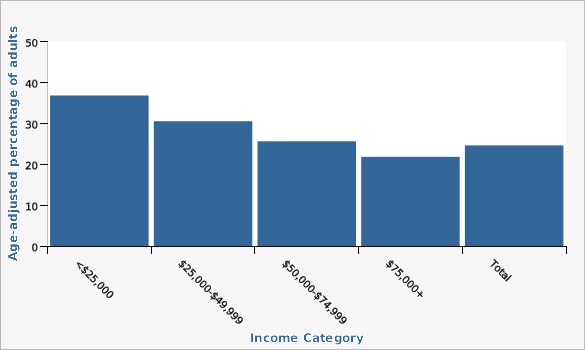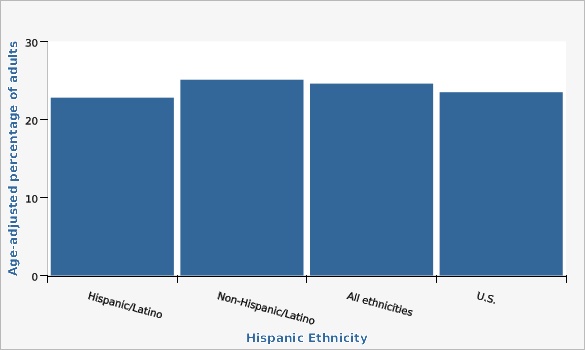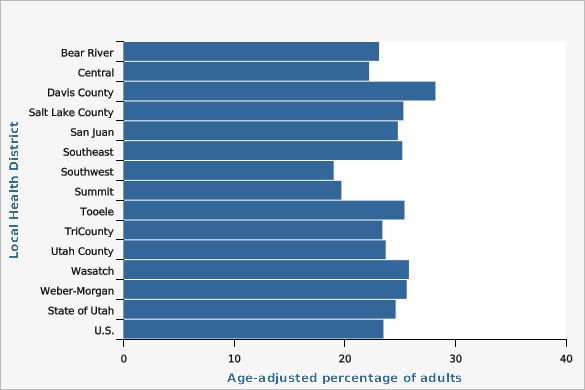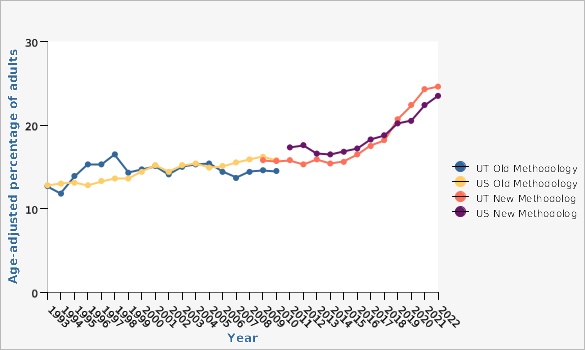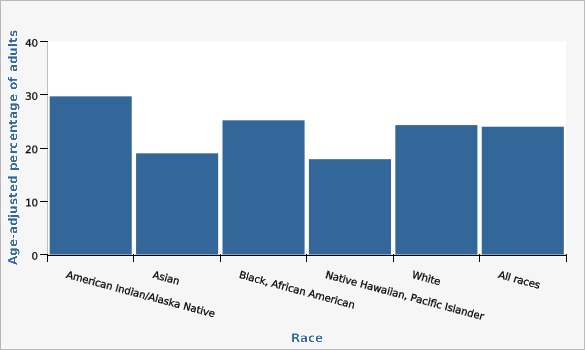Complete Health Indicator Report of Health Status: Mental Health Past 30 Days
Definition
Percentage of adults aged 18 years and older who reported seven or more days when their mental health was not good in the past 30 days.Numerator
Number of survey respondents who reported seven or more days when their mental health was not good in the past 30 days.Denominator
Total number of survey respondents excluding those with missing, "Don't know/Not sure," and "Refused" responses.Data Interpretation Issues
Question Text: "Now thinking about your mental health, which includes stress, depression, and problems with emotions, for how many days during the past 30 days was your mental health NOT good?" Increased number of U.S. households without landline phones and an under-representation of certain demographic groups that were not well-represented in the sample. More details about these changes can be found at: [https://ibis.health.utah.gov/pdf/opha/resource/brfss/RakingImpact2011.pdf]. As with all surveys, some error results from non-response (e.g., refusal to participate in the survey or to answer specific questions), and measurement (e.g., social desirability or recall bias). Error was minimized by use of strict calling protocols, good questionnaire design, standardization of interviewer behavior, interviewer training, and frequent, on-site interviewer monitoring and supervision.Why Is This Important?
Mental health refers to an individual's ability to negotiate the daily challenges and social interactions of life without experiencing undue emotional or behavioral incapacity. Mental health and mental disorders can be influenced by numerous conditions including biologic and genetic vulnerabilities, acute or chronic physical dysfunction, and environmental conditions and stresses. The BRFSS mental health question is an attempt to obtain a global measure of recent mental and emotional distress.How Are We Doing?
In 2022, approximately 25.4% (crude rate) of Utah adults reported seven or more days when their mental health was not good in the past 30 days. This percentage was higher for adults with lower income levels. Older adults are less likely to report poor mental health status. In order to analyze the BRFSS data by race, we combined years 2020-2022 using the new BRFSS methodology. According to this analysis using age-adjusted rates, the American Indian/Native Alaskan population reported the highest percentage of seven or more days when their mental health was not good in the past 30 days (29.7%) while Utah Pacific Islander adults reported the lowest percentage (17.9%).How Do We Compare With the U.S.?
Looking at age-adjusted rates for 2022, more Utah adults reported seven or more days when their mental health was not good in the past 30 days (24.6%) when compared to adults in the U.S. as a whole (23.5%), though the difference was not statistically significant.Available Services
The Utah Department of Health and Human Services Office of Substance Abuse and Mental Health (OSUMH) is Utah's public mental health and substance use authority. This office consults and coordinates with federal, state, and local partners regarding programs and services. The office also contracts for substance use and mental health programs funded with state and federal funds. In crisis? Call the Utah Crisis Line (988) for immediate, free, confidential support. 24 hours, 7 days a week.Related Indicators
Relevant Population Characteristics
The percentage of people reporting at least seven mentally unhealthy days out of the past 30 decreased with increasing age and income, and was higher for women than for men.Related Relevant Population Characteristics Indicators:
Health Care System Factors
Health insurance coverage for mental health problems is often inadequate for persons requiring long-term outpatient psychotherapy. Many psychotherapeutic medications (such as antidepressants and anti-anxiety drugs) are prescribed by primary care physicians. Primary care visits are an opportunity to identify and treat some mental health problems.Related Health Care System Factors Indicators:
Health Status Outcomes
Persons who are depressed are at risk for suicide and substance abuse. Depression has also been linked to physical disease, such as heart disease. Persons with mental disorders are often less successful at negotiating the challenges of educational completion and career advancement. As a result, they are at risk for problems associated with poverty.Related Health Status Outcomes Indicators:
Graphical Data Views
| Males vs. Females | Age Group | Percentage of adults | Lower Limit | Upper Limit | ||
|---|---|---|---|---|---|---|
Record Count: 12 | ||||||
| Male | 18-34 | 29.8% | 26.8% | 33.1% | ||
| Male | 35-49 | 19.1% | 16.4% | 22.0% | ||
| Male | 50-64 | 11.7% | 9.5% | 14.3% | ||
| Male | 65+ | 10.7% | 8.6% | 13.3% | ||
| Female | 18-34 | 45.7% | 41.9% | 49.5% | ||
| Female | 35-49 | 27.6% | 24.6% | 30.9% | ||
| Female | 50-64 | 23.4% | 20.1% | 26.9% | ||
| Female | 65+ | 14.9% | 12.4% | 17.7% | ||
Data Source
Utah Department of Health and Human Services Behavioral Risk Factor Surveillance System (BRFSS) [https://ibis.health.utah.gov/ibisph-view/query/selection/brfss/BRFSSSelection.html]| Age Group | Percentage of adults | Lower Limit | Upper Limit | |||
|---|---|---|---|---|---|---|
Record Count: 4 | ||||||
| 18-34 | 37.5% | 35.1% | 40.0% | |||
| 35-49 | 23.3% | 21.3% | 25.5% | |||
| 50-64 | 17.5% | 15.5% | 19.7% | |||
| 65+ | 12.9% | 11.2% | 14.8% | |||
Data Source
Utah Department of Health and Human Services Behavioral Risk Factor Surveillance System (BRFSS) [https://ibis.health.utah.gov/ibisph-view/query/selection/brfss/BRFSSSelection.html]| Education Level | Age-adjusted percentage of adults 25+ | Lower Limit | Upper Limit | |||
|---|---|---|---|---|---|---|
Record Count: 5 | ||||||
| Less than high school | 25.0% | 20.1% | 30.7% | |||
| H.S. grad or G.E.D. | 21.6% | 19.3% | 24.2% | |||
| Some post high school | 25.8% | 23.7% | 28.1% | |||
| College graduate | 18.1% | 16.6% | 19.7% | |||
| Total | 22.0% | 20.8% | 23.2% | |||
Data Notes
Age-adjusted to the U.S. 2000 standard population.Data Source
Utah Department of Health and Human Services Behavioral Risk Factor Surveillance System (BRFSS) [https://ibis.health.utah.gov/ibisph-view/query/selection/brfss/BRFSSSelection.html]| Income Category | Age-adjusted percentage of adults | Lower Limit | Upper Limit | |||
|---|---|---|---|---|---|---|
Record Count: 6 | ||||||
| <$25,000 | 36.8% | 31.7% | 42.2% | |||
| $25,000-$49,999 | 30.5% | 27.6% | 33.5% | |||
| $50,000-$74,999 | 25.6% | 22.7% | 28.8% | |||
| $75,000+ | 21.8% | 20.0% | 23.7% | |||
| Total | 24.6% | 23.5% | 25.8% | |||
Data Notes
Age-adjusted to the U.S. 2000 standard population.Data Source
Utah Department of Health and Human Services Behavioral Risk Factor Surveillance System (BRFSS) [https://ibis.health.utah.gov/ibisph-view/query/selection/brfss/BRFSSSelection.html]| Hispanic Ethnicity | Age-adjusted percentage of adults | Lower Limit | Upper Limit | |||
|---|---|---|---|---|---|---|
Record Count: 4 | ||||||
| Hispanic/Latino | 22.8% | 19.9% | 26.1% | |||
| Non-Hispanic/Latino | 25.1% | 23.8% | 26.3% | |||
| All ethnicities | 24.6% | 23.8% | 26.3% | |||
| U.S. | 23.5% | 22.2% | 24.8% | |||
Data Notes
Age adjusted to the U.S. 2000 standard population.Data Sources
- Utah Department of Health and Human Services Behavioral Risk Factor Surveillance System (BRFSS) [https://ibis.health.utah.gov/ibisph-view/query/selection/brfss/BRFSSSelection.html]
- Behavioral Risk Factor Surveillance System Survey Data, US Department of Health and Human Services Centers for Disease Control and Prevention (CDC).
| Local Health District | Age-adjusted percentage of adults | Lower Limit | Upper Limit | |||
|---|---|---|---|---|---|---|
Record Count: 15 | ||||||
| Bear River | 23.1% | 19.2% | 27.5% | |||
| Central | 22.2% | 17.2% | 28.2% | |||
| Davis County | 28.2% | 24.7% | 32.1% | |||
| Salt Lake County | 25.3% | 23.3% | 27.5% | |||
| San Juan | 24.8% | 15.0% | 38.0% | |||
| Southeast | 25.2% | 19.0% | 32.7% | |||
| Southwest | 19.0% | 15.6% | 22.9% | |||
| Summit | 19.7% | 12.7% | 29.3% | |||
| Tooele | 25.4% | 20.6% | 30.9% | |||
| TriCounty | 23.4% | 17.2% | 31.1% | |||
| Utah County | 23.7% | 21.4% | 26.2% | |||
| Wasatch | 25.8% | 17.8% | 35.8% | |||
| Weber-Morgan | 25.6% | 22.1% | 29.4% | |||
| State of Utah | 24.6% | 23.4% | 25.8% | |||
| U.S. | 23.5% | 22.2% | 24.8% | |||
Data Notes
Age-adjusted to the U.S. 2000 standard population. Note: At the time of this update, the BRFSS U.S. dataset did not include an age variable but did include five age categories up to age 80+ (vs. the typical weighting scheme that includes 85+). Comparisons with both weighting schemes were compared using Utah data, and the difference was about 1/100 of a percentage point.Data Sources
- Utah Department of Health and Human Services Behavioral Risk Factor Surveillance System (BRFSS) [https://ibis.health.utah.gov/ibisph-view/query/selection/brfss/BRFSSSelection.html]
- Behavioral Risk Factor Surveillance System Survey Data, US Department of Health and Human Services Centers for Disease Control and Prevention (CDC).
Seven or more days of poor mental health in the past 30 days by Utah Small Area, 2020-2022 and U.S. 2022
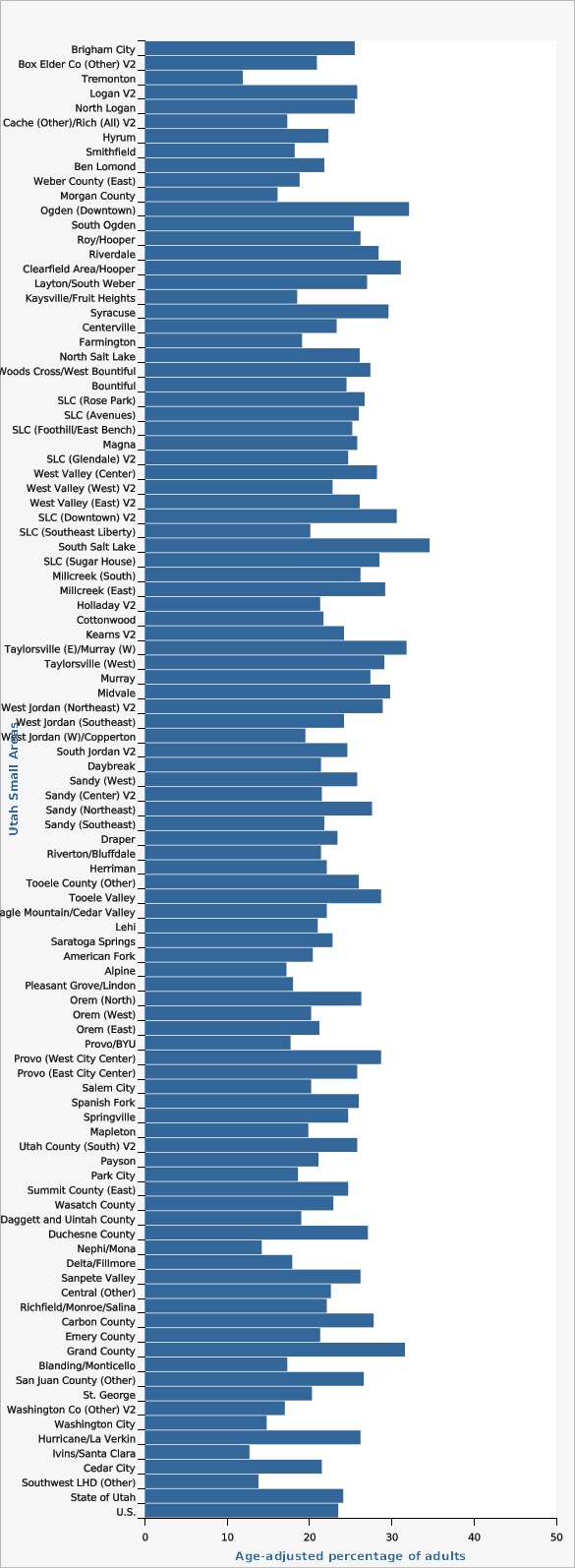
| Utah Small Areas | Age-adjusted percentage of adults | Lower Limit | Upper Limit | Note | ||
|---|---|---|---|---|---|---|
Record Count: 101 | ||||||
| Brigham City | 25.5% | 19.4% | 32.7% | |||
| Box Elder Co (Other) V2 | 20.9% | 13.8% | 30.2% | |||
| Tremonton | 11.9% | 7.2% | 18.9% | |||
| Logan V2 | 25.8% | 21.7% | 30.5% | |||
| North Logan | 25.5% | 19.2% | 33.0% | |||
| Cache (Other)/Rich (All) V2 | 17.3% | 12.0% | 24.3% | |||
| Hyrum | 22.3% | 12.9% | 35.7% | |||
| Smithfield | 18.2% | 12.0% | 26.5% | |||
| Ben Lomond | 21.8% | 18.1% | 26.1% | |||
| Weber County (East) | 18.8% | 14.0% | 24.8% | |||
| Morgan County | 16.1% | 9.0% | 27.3% | * | ||
| Ogden (Downtown) | 32.1% | 26.7% | 38.0% | |||
| South Ogden | 25.4% | 20.6% | 31.0% | |||
| Roy/Hooper | 26.2% | 21.2% | 31.8% | |||
| Riverdale | 28.4% | 21.1% | 36.9% | |||
| Clearfield Area/Hooper | 31.1% | 26.5% | 36.1% | |||
| Layton/South Weber | 27.0% | 23.0% | 31.4% | |||
| Kaysville/Fruit Heights | 18.5% | 13.5% | 24.9% | |||
| Syracuse | 29.6% | 23.8% | 36.1% | |||
| Centerville | 23.3% | 15.3% | 33.9% | |||
| Farmington | 19.1% | 12.4% | 28.2% | |||
| North Salt Lake | 26.1% | 17.9% | 36.3% | |||
| Woods Cross/West Bountiful | 27.4% | 19.2% | 37.5% | |||
| Bountiful | 24.5% | 19.5% | 30.3% | |||
| SLC (Rose Park) | 26.7% | 20.1% | 34.5% | |||
| SLC (Avenues) | 26.0% | 18.8% | 34.8% | |||
| SLC (Foothill/East Bench) | 25.2% | 17.5% | 34.9% | |||
| Magna | 25.8% | 19.9% | 32.8% | |||
| SLC (Glendale) V2 | 24.7% | 17.2% | 34.1% | |||
| West Valley (Center) | 28.2% | 22.6% | 34.5% | |||
| West Valley (West) V2 | 22.8% | 17.0% | 29.8% | |||
| West Valley (East) V2 | 26.1% | 20.9% | 32.1% | |||
| SLC (Downtown) V2 | 30.6% | 24.8% | 37.1% | |||
| SLC (Southeast Liberty) | 20.1% | 14.2% | 27.7% | |||
| South Salt Lake | 34.6% | 27.4% | 42.7% | |||
| SLC (Sugar House) | 28.5% | 22.6% | 35.3% | |||
| Millcreek (South) | 26.2% | 18.0% | 36.4% | |||
| Millcreek (East) | 29.2% | 22.3% | 37.2% | |||
| Holladay V2 | 21.3% | 14.6% | 30.2% | |||
| Cottonwood | 21.7% | 16.2% | 28.5% | |||
| Kearns V2 | 24.2% | 18.8% | 30.6% | |||
| Taylorsville (E)/Murray (W) | 31.8% | 25.6% | 38.6% | |||
| Taylorsville (West) | 29.1% | 23.5% | 35.5% | |||
| Murray | 27.4% | 21.4% | 34.3% | |||
| Midvale | 29.8% | 23.7% | 36.8% | |||
| West Jordan (Northeast) V2 | 28.9% | 22.7% | 36.0% | |||
| West Jordan (Southeast) | 24.2% | 18.6% | 30.9% | |||
| West Jordan (W)/Copperton | 19.5% | 15.1% | 24.9% | |||
| South Jordan V2 | 24.6% | 18.8% | 31.5% | |||
| Daybreak | 21.4% | 15.9% | 28.0% | |||
| Sandy (West) | 25.8% | 17.4% | 36.4% | |||
| Sandy (Center) V2 | 21.5% | 15.4% | 29.2% | |||
| Sandy (Northeast) | 27.6% | 19.2% | 37.9% | |||
| Sandy (Southeast) | 21.8% | 15.8% | 29.2% | |||
| Draper | 23.4% | 18.1% | 29.6% | |||
| Riverton/Bluffdale | 21.4% | 17.0% | 26.5% | |||
| Herriman | 22.1% | 17.1% | 28.1% | |||
| Tooele County (Other) | 26.0% | 19.0% | 34.4% | |||
| Tooele Valley | 28.7% | 25.1% | 32.7% | |||
| Eagle Mountain/Cedar Valley | 22.1% | 17.1% | 28.2% | |||
| Lehi | 21.0% | 17.4% | 25.0% | |||
| Saratoga Springs | 22.8% | 17.4% | 29.3% | |||
| American Fork | 20.4% | 16.1% | 25.6% | |||
| Alpine | 17.2% | 9.0% | 30.5% | |||
| Pleasant Grove/Lindon | 18.0% | 14.3% | 22.4% | |||
| Orem (North) | 26.3% | 20.8% | 32.7% | |||
| Orem (West) | 20.2% | 16.3% | 24.8% | |||
| Orem (East) | 21.2% | 15.6% | 28.3% | |||
| Provo/BYU | 17.7% | 13.7% | 22.6% | |||
| Provo (West City Center) | 28.7% | 22.8% | 35.4% | |||
| Provo (East City Center) | 25.8% | 19.1% | 33.9% | |||
| Salem City | 20.2% | 11.6% | 32.9% | * | ||
| Spanish Fork | 26.0% | 20.7% | 32.2% | |||
| Springville | 24.7% | 19.6% | 30.6% | |||
| Mapleton | 19.9% | 13.5% | 28.2% | * | ||
| Utah County (South) V2 | 25.8% | 18.2% | 35.3% | |||
| Payson | 21.1% | 15.7% | 27.8% | |||
| Park City | 18.6% | 13.3% | 25.5% | |||
| Summit County (East) | 24.7% | 17.8% | 33.4% | |||
| Wasatch County | 22.9% | 17.9% | 28.7% | |||
| Daggett and Uintah County | 19.0% | 15.7% | 22.7% | |||
| Duchesne County | 27.1% | 21.8% | 33.2% | |||
| Nephi/Mona | 14.2% | 8.1% | 23.7% | |||
| Delta/Fillmore | 17.9% | 11.8% | 26.3% | |||
| Sanpete Valley | 26.2% | 20.5% | 32.9% | |||
| Central (Other) | 22.6% | 17.5% | 28.6% | |||
| Richfield/Monroe/Salina | 22.1% | 16.6% | 28.9% | |||
| Carbon County | 27.8% | 22.8% | 33.5% | |||
| Emery County | 21.3% | 14.4% | 30.3% | |||
| Grand County | 31.6% | 23.0% | 41.7% | |||
| Blanding/Monticello | 17.3% | 11.5% | 25.2% | |||
| San Juan County (Other) | 26.6% | 17.1% | 39.0% | |||
| St. George | 20.3% | 16.8% | 24.3% | |||
| Washington Co (Other) V2 | 17.0% | 9.5% | 28.6% | * | ||
| Washington City | 14.8% | 9.8% | 21.6% | |||
| Hurricane/La Verkin | 26.2% | 18.7% | 35.3% | |||
| Ivins/Santa Clara | 12.7% | 7.1% | 21.6% | |||
| Cedar City | 21.5% | 16.9% | 27.1% | |||
| Southwest LHD (Other) | 13.8% | 8.9% | 20.6% | |||
| State of Utah | 24.1% | 23.4% | 24.7% | |||
| U.S. | 23.5% | 22.2% | 24.8% | |||
Data Notes
Age-adjusted to U.S. 2000 standard population. *Use caution in interpreting; the estimate has a coefficient of variation >30% and is therefore deemed unreliable by Utah Department of Health and Human Services standards. A description of the Utah Small Areas may be found on IBIS at the following URL: [https://ibis.health.utah.gov/resource/Guidelines.html].Data Sources
- Utah Department of Health and Human Services Behavioral Risk Factor Surveillance System (BRFSS) [https://ibis.health.utah.gov/ibisph-view/query/selection/brfss/BRFSSSelection.html]
- Behavioral Risk Factor Surveillance System Survey Data, US Department of Health and Human Services Centers for Disease Control and Prevention (CDC).
| BRFSS Utah vs. U.S. | Year | Age-adjusted percentage of adults | Lower Limit | Upper Limit | ||
|---|---|---|---|---|---|---|
Record Count: 62 | ||||||
| UT Old Methodology | 1993 | 12.7% | 11.0% | 14.4% | ||
| UT Old Methodology | 1994 | 11.8% | 10.2% | 13.4% | ||
| UT Old Methodology | 1995 | 13.9% | 12.3% | 15.5% | ||
| UT Old Methodology | 1996 | 15.3% | 13.7% | 17.0% | ||
| UT Old Methodology | 1997 | 15.3% | 13.6% | 16.9% | ||
| UT Old Methodology | 1998 | 16.5% | 14.7% | 18.3% | ||
| UT Old Methodology | 1999 | 14.3% | 12.6% | 16.0% | ||
| UT Old Methodology | 2000 | 14.7% | 13.1% | 16.3% | ||
| UT Old Methodology | 2001 | 15.1% | 13.7% | 16.6% | ||
| UT Old Methodology | 2002 | 14.1% | 12.7% | 15.5% | ||
| UT Old Methodology | 2003 | 15.0% | 13.5% | 16.4% | ||
| UT Old Methodology | 2004 | 15.3% | 14.0% | 16.5% | ||
| UT Old Methodology | 2005 | 15.4% | 14.3% | 16.7% | ||
| UT Old Methodology | 2006 | 14.4% | 13.2% | 15.7% | ||
| UT Old Methodology | 2007 | 13.7% | 12.4% | 15.0% | ||
| UT Old Methodology | 2008 | 14.4% | 13.2% | 15.8% | ||
| UT Old Methodology | 2009 | 14.6% | 13.7% | 15.6% | ||
| UT Old Methodology | 2010 | 14.5% | 13.9% | 15.2% | ||
| US Old Methodology | 1993 | 12.8% | 12.5% | 13.1% | ||
| US Old Methodology | 1994 | 13.0% | 12.7% | 13.3% | ||
| US Old Methodology | 1995 | 13.1% | 12.8% | 13.5% | ||
| US Old Methodology | 1996 | 12.8% | 12.5% | 13.1% | ||
| US Old Methodology | 1997 | 13.3% | 13.0% | 13.6% | ||
| US Old Methodology | 1998 | 13.6% | 13.3% | 13.8% | ||
| US Old Methodology | 1999 | 13.6% | 13.3% | 13.9% | ||
| US Old Methodology | 2000 | 14.4% | 14.1% | 14.7% | ||
| US Old Methodology | 2001 | 15.2% | 14.9% | 15.4% | ||
| US Old Methodology | 2002 | 14.4% | 13.9% | 14.8% | ||
| US Old Methodology | 2003 | 15.2% | 14.9% | 15.4% | ||
| US Old Methodology | 2004 | 15.4% | 15.1% | 15.7% | ||
| US Old Methodology | 2005 | 14.9% | 14.7% | 15.2% | ||
| US Old Methodology | 2006 | 15.1% | 14.8% | 15.4% | ||
| US Old Methodology | 2007 | 15.5% | 15.3% | 15.8% | ||
| US Old Methodology | 2008 | 15.9% | 15.7% | 16.2% | ||
| US Old Methodology | 2009 | 16.2% | 15.9% | 16.4% | ||
| US Old Methodology | 2010 | 15.8% | 15.5% | 15.9% | ||
| UT New Methodology | 2009 | 15.8% | 14.9% | 16.8% | ||
| UT New Methodology | 2010 | 15.7% | 14.9% | 16.6% | ||
| UT New Methodology | 2011 | 15.8% | 15.0% | 16.7% | ||
| UT New Methodology | 2012 | 15.3% | 14.5% | 16.2% | ||
| UT New Methodology | 2013 | 15.9% | 15.1% | 16.7% | ||
| UT New Methodology | 2014 | 15.4% | 14.7% | 16.1% | ||
| UT New Methodology | 2015 | 15.6% | 14.7% | 16.4% | ||
| UT New Methodology | 2016 | 16.5% | 15.6% | 17.5% | ||
| UT New Methodology | 2017 | 17.5% | 16.6% | 18.5% | ||
| UT New Methodology | 2018 | 18.2% | 17.3% | 19.1% | ||
| UT New Methodology | 2019 | 20.7% | 19.7% | 21.6% | ||
| UT New Methodology | 2020 | 22.4% | 21.4% | 23.5% | ||
| UT New Methodology | 2021 | 24.3% | 23.3% | 25.4% | ||
| UT New Methodology | 2022 | 24.6% | 23.5% | 25.8% | ||
| US New Methodology | 2011 | 17.3% | 17.1% | 17.6% | ||
| US New Methodology | 2012 | 17.6% | 17.3% | 17.8% | ||
| US New Methodology | 2013 | 16.6% | 16.4% | 16.8% | ||
| US New Methodology | 2014 | 16.5% | 16.2% | 16.7% | ||
| US New Methodology | 2015 | 16.8% | 13.9% | 19.6% | ||
| US New Methodology | 2016 | 17.2% | 16.9% | 17.4% | ||
| US New Methodology | 2017 | 18.3% | 18.0% | 18.6% | ||
| US New Methodology | 2018 | 18.8% | 18.5% | 19.0% | ||
| US New Methodology | 2019 | 20.2% | 19.9% | 20.5% | ||
| US New Methodology | 2020 | 20.5% | 20.2% | 20.9% | ||
| US New Methodology | 2021 | 22.4% | 22.1% | 22.7% | ||
| US New Methodology | 2022 | 23.5% | 22.2% | 24.8% | ||
Data Notes
Age-adjusted to the U.S. 2000 standard population. U.S. data are the average for all states and the District of Columbia but do not include the U.S. territories. In 2002 the U.S. data includes only 22 states that asked the question. Starting in 2009, the BRFSS included both landline and cell phone respondent interviews along with a new weighting methodology called iterative proportional fitting, or raking. More details about these changes can be found at: [https://ibis.health.utah.gov/pdf/opha/resource/brfss/RakingImpact2011.pdf]. Note: At the time of this update, the BRFSS U.S. dataset did not include an age variable but did include five age categories up to age 80+ (vs. the typical weighting scheme that includes 85+). Comparisons with both weighting schemes were compared using Utah data, and the difference was about 1/100 of a percentage point.Data Sources
- Utah Department of Health and Human Services Behavioral Risk Factor Surveillance System (BRFSS) [https://ibis.health.utah.gov/ibisph-view/query/selection/brfss/BRFSSSelection.html]
- Behavioral Risk Factor Surveillance System Survey Data, US Department of Health and Human Services Centers for Disease Control and Prevention (CDC).
| Race | Age-adjusted percentage of adults | Lower Limit | Upper Limit | |||
|---|---|---|---|---|---|---|
Record Count: 6 | ||||||
| American Indian/Alaska Native | 29.7% | 24.6% | 35.5% | |||
| Asian | 19.0% | 15.0% | 23.7% | |||
| Black, African American | 25.2% | 20.2% | 31.0% | |||
| Native Hawaiian, Pacific Islander | 17.9% | 12.3% | 25.3% | |||
| White | 24.3% | 23.7% | 25.0% | |||
| All races | 24.0% | 23.4% | 24.6% | |||
Data Notes
Age-adjusted to the U.S. 2000 standard population based on 3 age groups: 18-34, 35-49, and 50+.Data Sources
- Utah Department of Health and Human Services Behavioral Risk Factor Surveillance System (BRFSS) [https://ibis.health.utah.gov/ibisph-view/query/selection/brfss/BRFSSSelection.html]
- Behavioral Risk Factor Surveillance System Survey Data, US Department of Health and Human Services Centers for Disease Control and Prevention (CDC).
References and Community Resources
U.S. Department of Health and Human Services, Substance Abuse and Mental Health Services Administration (SAMHSA): [http://www.samhsa.gov/] National Institute of Mental Health: [http://www.nimh.nih.gov/] More information on the Behavioral Risk Factor Surveillance System may be found on the website of the Centers for Disease Control and Prevention - [http://www.cdc.gov/brfss/]More Resources and Links
Evidence-based community health improvement ideas and interventions may be found at the following sites:- Centers for Disease Control and Prevention (CDC) WONDER Database, a system for disseminating public health data and information.
- United States Census Bureau data dashboard.
- Utah healthy Places Index, evidence-based and peer-reviewed tool, supports efforts to prioritize equitable community investments, develop critical programs and policies across the state, and much more.
- County Health Rankings
- Kaiser Family Foundation's StateHealthFacts.org
- Medical literature can be queried at PubMed library.
Page Content Updated On 11/17/2023,
Published on 04/11/2024

